When you first hear the name “jaguar cichlid,” many images may come to mind.
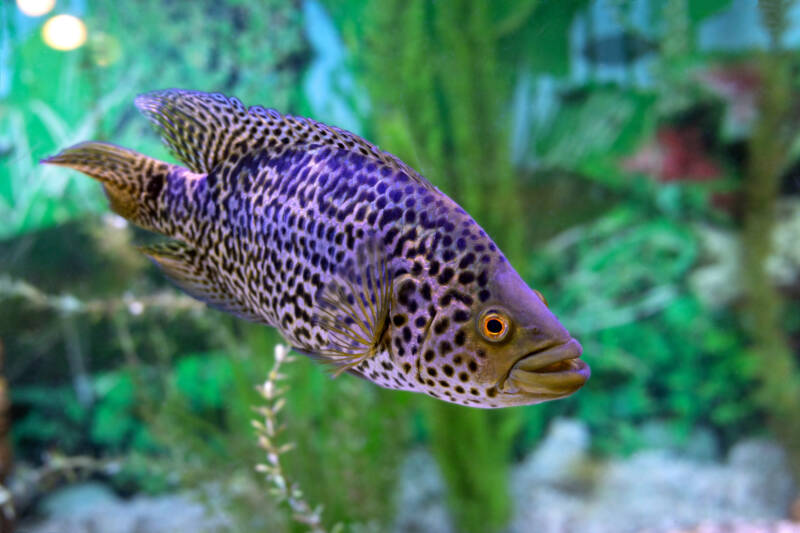
Let me tell you, this freshwater species is aptly named. From its spotted coloration reminiscent of its namesake’s coat to its hunting prowess, to its fierce personality, the jaguar cichlid covers all the bases.
Keeping jaguar cichlids, however, is not for everyone. Many breeders will recommend that you have some experience in caring for fish, and cichlid species in particular, before taking on the jaguar.
They are known as aggressive cichlid, which means some extra attention on the part of their keeper to ensure they are housed correctly. They also grow very big, require a large tank, and a high protein diet.
For those willing to take on the challenge, the jaguar cichlid is a hardy, active, and long-lived species.
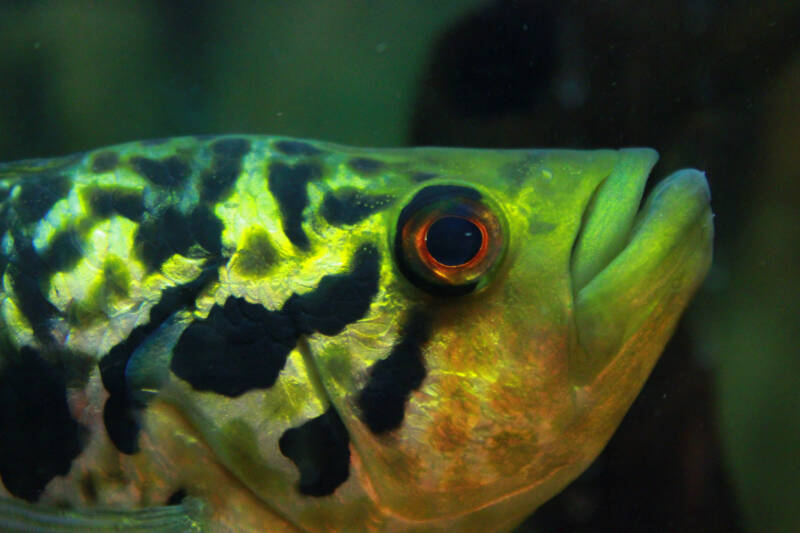
Read on for more information and answers to your questions on the care, feeding, and breeding of this fascinating fish.
At a glance
| Tank Size: | 30 gallons for juvenile, 70 gallons for a single adult |
| Group Size: | Single fish or bonded pairs |
| Water Temperature: | 73 to 82°F (23 to 28°C) |
| pH: | 7.0 to 8.7 (7.7 is best) |
| Hardness: | 10 to 15 dGH |
| Lifespan: | 15 years |
| Breeding: | Egg layer |
| Adult Size: | 14 to 16 inches (36 to 41 cm) |
| Usual Place in the Tank: | Bottom half |
[toc]
Natural Habitat
The jaguar cichlid is native to Central America. The species was originally discovered in Lake Managua in Nicaragua.
Now due to importation and the aquarium trade, this fish can be found in freshwater bodies in Honduras, Costa Rica, Mexico, Panama, and as far away as Florida and Singapore.
The native waters of the jaguar cichlid are warm and have a neutral pH.
This fish is hardy and can inhabit various environments, including calm lakes, fast-moving streams, waters with thick vegetation, and those with low dissolved oxygen.
Appearance and Biology
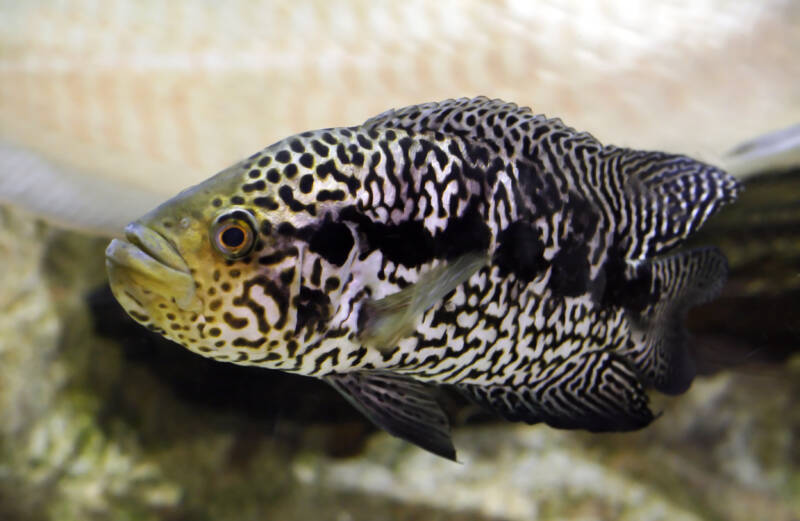
The jaguar cichlid (Parachromis managuensis) goes by many names, including the Managuense cichlid, Aztec cichlid, or locally, guapote tigre. This species has several attributes that enhance its ability as a predator.
Its body is flat and oval-shaped when viewed from the side, but slender and sleek from above, allowing it to move quickly through the water.
The dorsal and anal fins are swept backward and supported by stiff spines, which protect the fins from other predatory fish.
Finally, this fish has a large mouth with sharp incisors on the lower lip. The jaw can extend and allow the jaguar cichlid to swallow large prey.
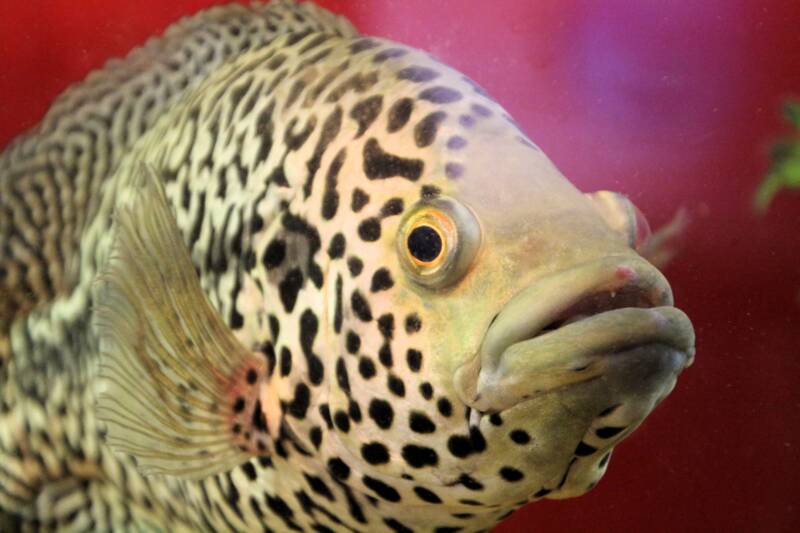
Do jaguar cichlids grow fast?Yes, they can grow large quickly. Within two months, they can reach a length of six inches (15 cm). It takes anywhere from a year to a year and a half to reach their full length.
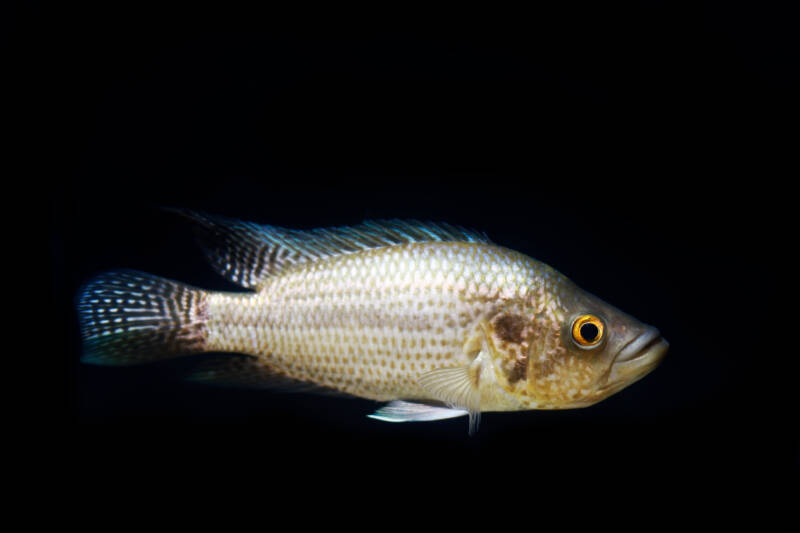
Do jaguar cichlids have teeth? Yes, its bottom jaw protrudes and sports two to four sharp incisors. In addition, the jaguar cichlid has a set of pharyngeal teeth located in its throat.
Coloration
As a juvenile fish, the jaguar cichlid features vertical black bands.
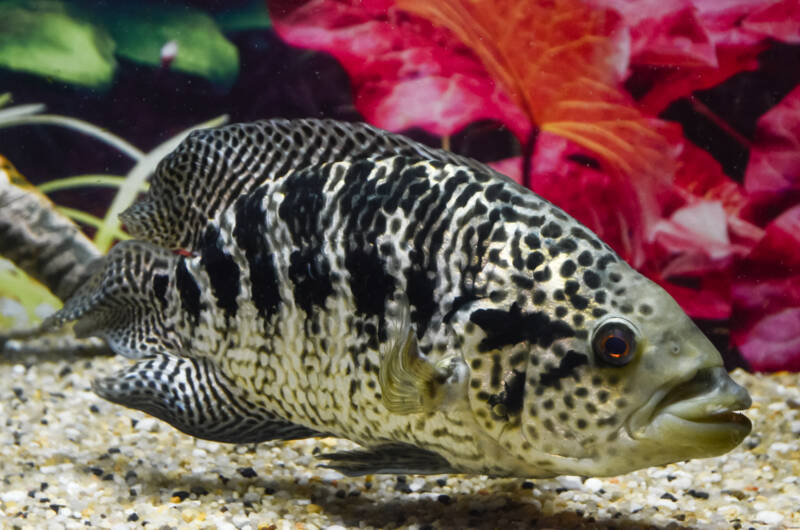
They will keep these bands up to the breeding age. At that time, the jaguar cichlid develops a color pattern reminiscent of its land animal namesake.
The spot pattern is unique for each fish. You may see faded vertical lines, and most of the time, the fish will have a horizontal line of larger black splotches starting just behind the eye and extending to the base of the tail. 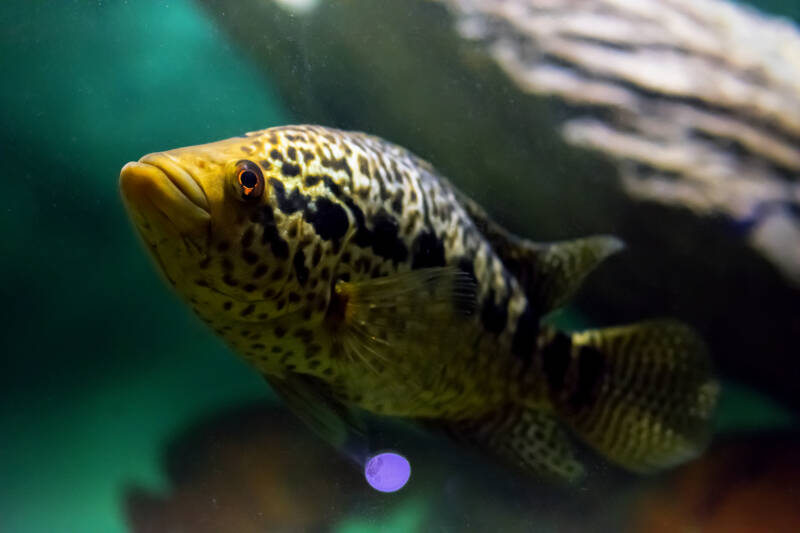
Gender Differences
How can I tell if my jaguar cichlid is male or female? Males are generally larger than females when fully grown. Their dorsal and anal fins are longer and taper to a point.
Size
As with many cichlid species, you can expect your jaguar cichlid to grow large. On average, this fish reaches an adult length between 14 to 16 inches (36 to 41 cm).
This slightly smaller than the length of up to two feet (60 cm) that they can reach in the wild!
Lifespan
If you take on a jaguar cichlid, be prepared for a long-term commitment. These fish can live for an average of 15 years, but with any aquarium species, this lifespan is directly impacted by the care you provide.
This fish needs consistent maintenance of water and tank conditions to ensure a long and healthy life.
Behavior
How aggressive are jaguar cichlids? Jaguar cichlids are classified as aggressive fish and can display this aggression toward other species in the tank as well as their own kind.
Even bonded pairs can be aggressive toward each other from time to time. Because of this, we recommend that individuals with some experience in cichlid care are the ones to take on this species in a home aquarium.
Cichlids are active swimmers and can be very territorial. If you keep more than one jaguar cichlid, be prepared to house them in a large enough tank so that they can each establish their own area.
Jaguars tend to hang around the bottom half of the tank and are active diggers, so make sure you line the bottom with a sandy or gravel substrate and secure any plants or decorations.
How many per gallon?
Juvenile fish can be kept in larger numbers in smaller tanks. Plan on a minimum tank size of at least 30 gallons for juvenile fish.
For an adult, raise that tank size to at least 70 gallons for a single fish.
Keep in mind that these are the minimum tank sizes. With a fish like the jaguar, which likes to swim and have its own space, a larger tank size is always better for their comfort and health.
A 100-gallon tank for a single cichlid is not unreasonable, and you can plan on upwards of 200 gallons if you want your fish to breed.
Tank Setup
Setting up a tank for your jaguar cichlid is simple. As always, the goal is to replicate their natural habitat.
Decorations
Line the bottom of your tank with a dark sand or gravel substrate. Siphon the bottom frequently to avoid the buildup of waste.
Again, jaguar cichlids are active diggers and love to rearrange their habitat, so consider floating plants or ones that you can secure to the bottom. The same goes for other decorative items.
Even with the jaguar cichlid’s gruff personality, they still like to have a secure place to hide. Consider adding rocks or caves near the edges of the tank and leave a large open swimming area toward the center.
Water Conditions
Jaguar cichlids tolerate a wide range of conditions; however, it is best to keep your aquarium’s water parameters consistent for the optimum health of your fish.
The jaguar cichlid can tolerate water temperatures ranging from 73 to 82 degrees Fahrenheit (23 to 28 C) but try to keep the temperature toward the middle of that range.
The pH range can also vary widely, anywhere from 7.0 to 8.7, but closer to 7.7 is best. Keep the water hardness around 10 to 15 dGH.
Equipment
Jaguar cichlids produce a good amount of waste, so select a sturdy filter.
Canister filters will handle the waste and reduce the potential for increased ammonia and nitrate. Make sure the filter can produce a strong current.
This fish does not have any specific lighting requirements. Any floating plants that you have in the tank will help provide some shade.
Because this fish prefers warm water, consider installing a heater to keep the temperature in a comfortable and consistent range.
Tank Mates
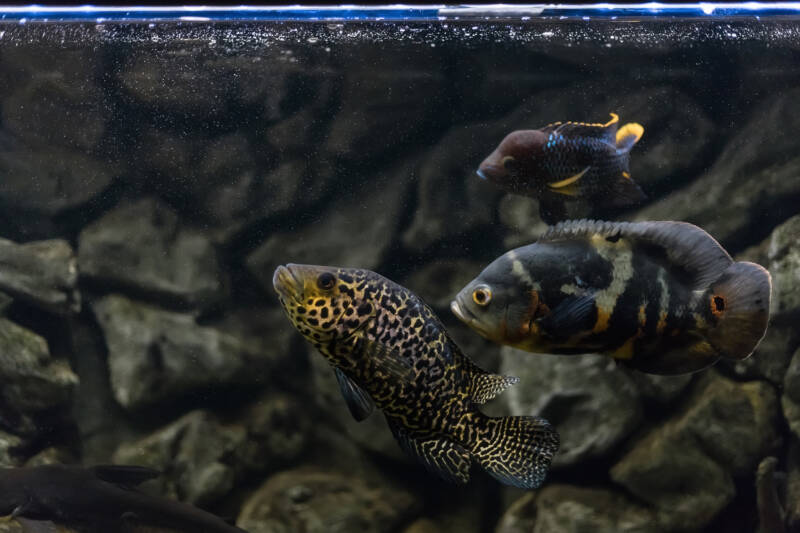
Selecting a tank mate for the jaguar cichlid can be tricky. This fish can be kept alone or with a bonded mate.
Other large, similarly tempered fish can make good tank mates, but even so, individual fish simply may not get along. Always monitor new additions to the tank for signs of aggression.
Occasionally, aggression can be resolved by using a larger tank that allows the fish to establish territories, ensuring adequate food supply, and upkeeping water conditions to reduce stress.
Can a jaguar cichlid live with an Oscar? Yes, but select an Oscar that is close to the same size. Oscars are also territorial, so make sure you have a large tank to allow each fish to establish a territory.
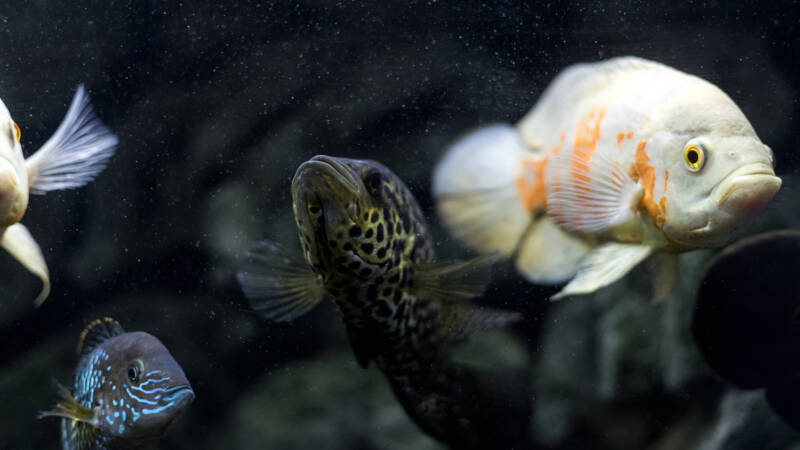
Consider the following to pair with your jaguar cichlid:
- Another jaguar cichlid (preferably a bonded pair or group of juveniles)
- Large cichlid species (red devil, convict, Midas, green terror, or flowerhorn)
- Oscars
- Large catfish
- Large plecos
Avoid the following:
- Anything smaller than the jaguar cichlid.
Food and Diet
What do jaguar cichlids eat? Jaguar cichlids do best with a high protein diet.
Stick to a regular feeding schedule and a single meal each day. Only feed as much as your fish can finish in a couple of minutes. Too much extra food will decay and cause water quality problems.
Try the following fresh or frozen foods with your jaguar cichlid:
- Feeder fish
- Worms (bloodworms or earthworms)
- Insects
- Prawns.
While they can be taught to eat commercial flakes or pellets, this works best when they are trained from a young age to accept the food.
Breeding
As we have mentioned, jaguar cichlids form bonded pairs. If you purchase the pair already bonded, that makes things simple.
Otherwise, you can purchase juvenile fish and let them form their own pairs naturally.
Determine Breeding Readiness
A bonded pair in a community tank ready to breed may show signs of aggression toward their other tank mates.
If the fish are the only ones in the tank, the only signal you may get that they are ready to breed is the female swelling with eggs.
You can stimulate breeding by feeding the bonded pair well. Change out 50 percent of the water in the breeding tank twice during the week and raise the temperature to the higher end of their tolerance range (around 82 degrees Fahrenheit, 28 degrees C).
Spawning
The female jaguar cichlid will deposit her eggs on a flat rock or inside a cave. Do not be surprised to see upwards of 2,000 eggs!
Once the male fertilizes the eggs, he will remain to protect them. He can be fierce in these actions, so make sure your bonded pair is in a separate breeding tank, or you may risk injury to your other fish.
Hatching and Care of Fry
It can take anywhere from five to seven days for the eggs to hatch. Both the male and female guard the eggs during this time and even protect the fry once they hatch.
The fry take about a week to become free-swimming. Once this happens, remove the parents and feed the fry baby brine shrimp. Change out 20 percent of the water every day or so.
Hardiness and Diseases
The jaguar cichlid is a hardy species and is not prone to any unique ailments.
As with any freshwater fish, if water conditions, tank cleanliness, and proper diet are not in order, then the fish can become stressed and more susceptible to disease.
One of the most common diseases seen in freshwater tanks is ich. Fortunately, this parasitic infection, which presents as white spots on the fish’s body, is easily treated with medication in the water.
Be sure to isolate any fish you observe with ich because they can easily pass the parasite to others in the aquarium. Treat ich as soon as possible as a lingering infection can kill your fish.
Closing Thoughts
Think about the unique requirements of the jaguar cichlid before making the decision to bring one home.
Due to their higher level of aggression, take care when selecting tank mates.
Their large size means they need a large tank to feel comfortable, plus a reliable filter and heater to keep water conditions stable. In addition, they require a regular, high protein diet and consistent tank cleaning.
If you have some experience in fish keeping and are looking for an active and interesting species, then the jaguar cichlid may be the one for you.
Hardy and long-lived, this fish will be a part of your life for a long time to come.
What is your experience with keeping jaguar cichlids?
Do you prefer to keep them in a single species tank or in a community tank?
